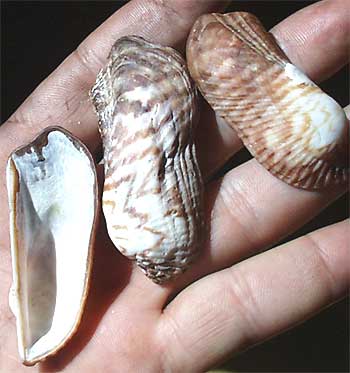Excerpts from Jim Conrad's
Naturalist Newsletter
from the February 25, 2006 Newsletter written at Hacienda San Juan Lizárraga one kilometer east of Telchac Pueblo, Yucatán, MÉXICO and issued from Hotel Reef Yucatan 13 kms to the north
TURKEY WING SEASHELLS

Usually the most eye-catching items washed up on the beach are seashells. In places, wave action has piled 20-ft-long and longer heaps of them -- nothing but ten-inch-deep deposits of mostly small and white shells that crunch beneath one's feet.
As the picture above shows, maybe the most distinctive and easy-to-identify shell is one a little over two inches long, oblong, with one side bulging out and the other side more or less straight. Low, narrow ridges radiate across the shell and, most strikingly, the whole shell is zebra-striped with white and rusty-red bands. Because the shells vaguely look like outstretched bird wings they're called Turkey Wings, ARCA ZEBRA.
Once you have the name of something, then you can look up the name in books and on the Internet to find out more about it. In Hotel Reef's computer room I did just that. I learned that living Turkey Wings attach themselves to coral rocks and wedge themselves into crevices. They occur from the low tide mark to as deep as 20 feet.
Also I found information that made this landlubber's face burn with shame. Without thinking much about it I'd been assuming that Turkey Wings were bivalves -- having two shells like clams -- but in the Computer Room I read that they're mollusks, and all the mollusks I know (basically snails and slugs) have either one or no shells. So, I jumped to the conclusion that Turkey Wings, being mollusks, just have one shell, and I wrote that in my Newsletter.
Sometime later Thomas E. Eichhorst, Editor of the American Conchologist magazine, wrote this to me:
Turkey wings are indeed mollusks, bivalved mollusks. Your turkey wing shells are bivalves consisting of two shells. The ones you find on the beach are long dead and have been separated into two separate valves and washed ashore. The odds of finding matching valves are not very good. If you find a live animal you will note that the valves fit together perfectly. The phylum Mollusca is divided into seven classes (and a couple of fossil classes): Aplacophora (about 250 wormlike species), Polyplacophora (the chitons, about 700 species), Monoplacophora (primitive limpet-like "living fossils," about 10 species), Cephalopoda (squids, octopi, and cephalopods, over 1,000 species), Schaphopoda (tusk or tooth shells, about 400 species), Bivalvia (also called Pelecypoda) (clams, scallops, mussels and the like, over 1,000 species), and Gastropoda (snails, slugs, nudibranchs, etc, over 30,000 species). Thus a shell can be both a bivalve (the class) and a mollusk (the phylum). Your turkey wing shells are bivalves consisting of two shells.
So, I really messed up that one. Probably it's a good thing I'm an inland naturalist not an marine one. Anyway, Turkey Wings are distributed from the shores of North Carolina south to Brazil and out to Bermuda. In Bermuda and Venezuela its flesh is often eaten.